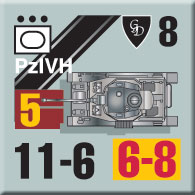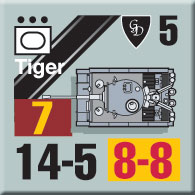Grossdeutschland 1944:
Scenario Preview, Part Four
by Mike Bennighof, Ph.D.
April 2025
 The two battles of Târgu Frumos are usually noted in histories of the Eastern Front (if they’re noted at all) as having been won by the skillful actions of Panzer Grenadier Division Grossdeutschland. And while much of that note is due to the equally skillful post-war self-promotion of division commander Hasso von Manteuffel, there’s a good deal of truth to it as well. The two battles of Târgu Frumos are usually noted in histories of the Eastern Front (if they’re noted at all) as having been won by the skillful actions of Panzer Grenadier Division Grossdeutschland. And while much of that note is due to the equally skillful post-war self-promotion of division commander Hasso von Manteuffel, there’s a good deal of truth to it as well.
Other divisions fought at Târgu Frumos in April and May 1944, and earned (but did not receive) credit for their performance, including the German 24th Panzer Division (which fought without the added weaponry of Grossdeutschland) and the Romanian Royal Guard Division (not, as one history has it, the Romanian 1st Armored Division, which was not fully formed and did not participate in the April-May battles).
And then there was the Waffen SS. The 3rd SS “Death’s Head” Panzer Division was present at Târgu Frumos, though with considerably fewer tanks than Grossdeutschland (but many more than 24th Panzer). Yet this “elite” division spent much of the battle in LVII Panzer Corps’ reserve, only coming to the front when dire emergencies beckoned and even then Manteuffel resolved some of these by stripping part of his own front of tanks rather than receiving aid from the SS.
The inescapable conclusion is that the SS simply were not very good at fighting enemies who might fight back. The “Death’s Head” division, one of the most loathsome units in any army in any era, had been formed from concentration camp guards and maintained a close association with the camps. After Târgu Frumos the division would be withdrawn from the front to receive large-scale reinforcements draft from another SS division and from the regular army’s conscript pool, indicating a lack of quality as well as quantity.
Chapter Four of Panzer Grenadier: Grossdeutschland 1944 covers the Death Head’s Division’s actions at Târgu Frumos. Let’s have a look at those scenarios.
Scenario Seventeen
Spoiled at Pascani
24 April 1944
 Romanian army intelligence detected a large buildup of Soviet forces north of Târgu Frumos, portending a coming offensive by I.S. Konev’s Second Ukrainian Front. The Romanian V Corps planned a series of spoiling attacks to disrupt these plans. The corps had operational control over the German Waffen SS 3rd “Death’s Head” Panzer Division, and ordered it to attack toward the town of Pascani alongside the Romanian 6th Infantry Division. Romanian army intelligence detected a large buildup of Soviet forces north of Târgu Frumos, portending a coming offensive by I.S. Konev’s Second Ukrainian Front. The Romanian V Corps planned a series of spoiling attacks to disrupt these plans. The corps had operational control over the German Waffen SS 3rd “Death’s Head” Panzer Division, and ordered it to attack toward the town of Pascani alongside the Romanian 6th Infantry Division.
Conclusion
The Romanian-German attack ground forward, but it took three days to capture Pascani. V Corps headquarters would not commit the bulk of the Waffen SS division’s armor, and eventually called a halt to the offensive as signs grew of Soviet intentions to attack in other sectors. The first day of the spoiling attack had seen some success, disrupting the Soviet divisions, but did not achieve all of its objectives.
Notes
This is a big scenario, a joint assault by a Romanian division and the Death’s Head, operating side-by-side with all sorts of boundary issues. The SS has strong armored support and a lot of artillery; the Romanians lack these things. That’s a problem, because the defenders have rough terrain on their side and plenty of heavy weapons to help them hold it.
Scenario Eighteen
Mount Hushenei
2 May 1944
 The long-awaited Soviet offensive came not on May Day, as expected, but 24 hours later. The 81st Guards Rifle Division pushed back the Romanian Royal Guards and Grossdeutschland, and 36th Guards Rifle Corps sent in its reserve division to exploit their success. Fifty-Seventh Panzer Corps in turn sent a battle group from the Death’s Head Division to stop them. The long-awaited Soviet offensive came not on May Day, as expected, but 24 hours later. The 81st Guards Rifle Division pushed back the Romanian Royal Guards and Grossdeutschland, and 36th Guards Rifle Corps sent in its reserve division to exploit their success. Fifty-Seventh Panzer Corps in turn sent a battle group from the Death’s Head Division to stop them.
Conclusion
The Waffen SS battle group, not faced with Soviet armor on this axis, stopped the Guards’ advance and helped stabilize the Axis line. The infantry of 36th Guards Rifle Corps had made good gains during the opening hours of the offensive, pushing back the Romanian Royal Guard Division and Grossdeutschland, but lacked the armor and mobility to get past a motorized defender.
Notes
This is a meeting engagement between a tough Guards Rifle Division and an SS battle group, fully motorized and backed by armor. The Soviets have strong artillery support, good numbers and better morale. But it’s hard for troops on foot to advance against a mobile enemy with tanks, even an incompetent one.
Scenario Nineteen
Tank Battle at Ruginoasa
2 May 1944
 After fending off repeated attacks Panzer Grenadier Division Grossdeutschland shifted its tank regiment to counter-attack the Soviets, opening a small gap in its line. The Soviet 29th Tank Corps poured through, and LVII Panzer Corps sent a battle group from the Death’s Head Division to seal the breach. After fending off repeated attacks Panzer Grenadier Division Grossdeutschland shifted its tank regiment to counter-attack the Soviets, opening a small gap in its line. The Soviet 29th Tank Corps poured through, and LVII Panzer Corps sent a battle group from the Death’s Head Division to seal the breach.
Conclusion
“As if summoned by a magic hand,” a Grossdeutschland trooper, trapped with a handful of comrades by the Soviet advance, wrote later, “the tanks and assault guns of the SS Division ‘Death’s Head’ suddenly appeared from the south; before any of the T-34s could take aim they had all been hit.” The SS counter-attack halted the Soviet tanks, allowing Grossdeutschland needed time to re-organize its defenses.
Notes
It’s another meeting engagement, this time a big tank battle as the Soviets bring on a wave of T-34’s to challenge the SS Tigers and PzKw IV’s. The Germans get airplanes, while the Soviets get artillery strong enough to squish a Tiger.
Scenario Twenty
The Guards Attack
3 May 1944
 Balked on the first day of the offensive, Second Ukrainian Front returned to the attack a day later with two tank armies now taking part even though no breakthrough had been achieved. The Death’s Head Division had been placed in the line exactly where one corps of Konev’s tanks was expected to strike. Balked on the first day of the offensive, Second Ukrainian Front returned to the attack a day later with two tank armies now taking part even though no breakthrough had been achieved. The Death’s Head Division had been placed in the line exactly where one corps of Konev’s tanks was expected to strike.
Conclusion
The Soviets had no success in any of their attacks, including that against the Death’s Head Division in one of its rare appearances holding a sector of the front line. Fifty-Seventh Panzer Corps appears not to have had much confidence in the SS division, keeping it in reserve most of the time and over-working Grossdeutschland’s tank regiment even as nearly 100 SS-manned vehicles sat idly by a few kilometers away.
Notes
This time the SS is on the defense, backed by assault guns, 88mm flak and airplanes. The Soviets have airplanes too and lots of T-34 tanks, plus they’re Guards with better morale than the armed criminals of the SS.
And that’s the fourth and final chapter.
You can order Grossdeutschland 1944 right here.
Red Storm Package
Broken Axis
Grossdeutschland 1944
Eastern Front Artillery
Retail Price: $139.97
Package Price: $110.00
Gold Club Price: $88.00
You can order the Red Storm Package right here.
Please allow an extra three weeks for delivery.
Sign up for our newsletter right here. Your info will never be sold or transferred; we'll just use it to update you on new games and new offers.
Mike Bennighof is president of Avalanche Press and holds a doctorate in history from Emory University. A Fulbright Scholar and NASA Journalist in Space finalist, he has published an unknowable number of books, games and articles on historical subjects.
He lives in Birmingham, Alabama with his wife and three children. He will never forget his dog, Leopold.
Want to keep Daily Content free of third-party ads? You can send us some love (and cash) through this link right here.
|
